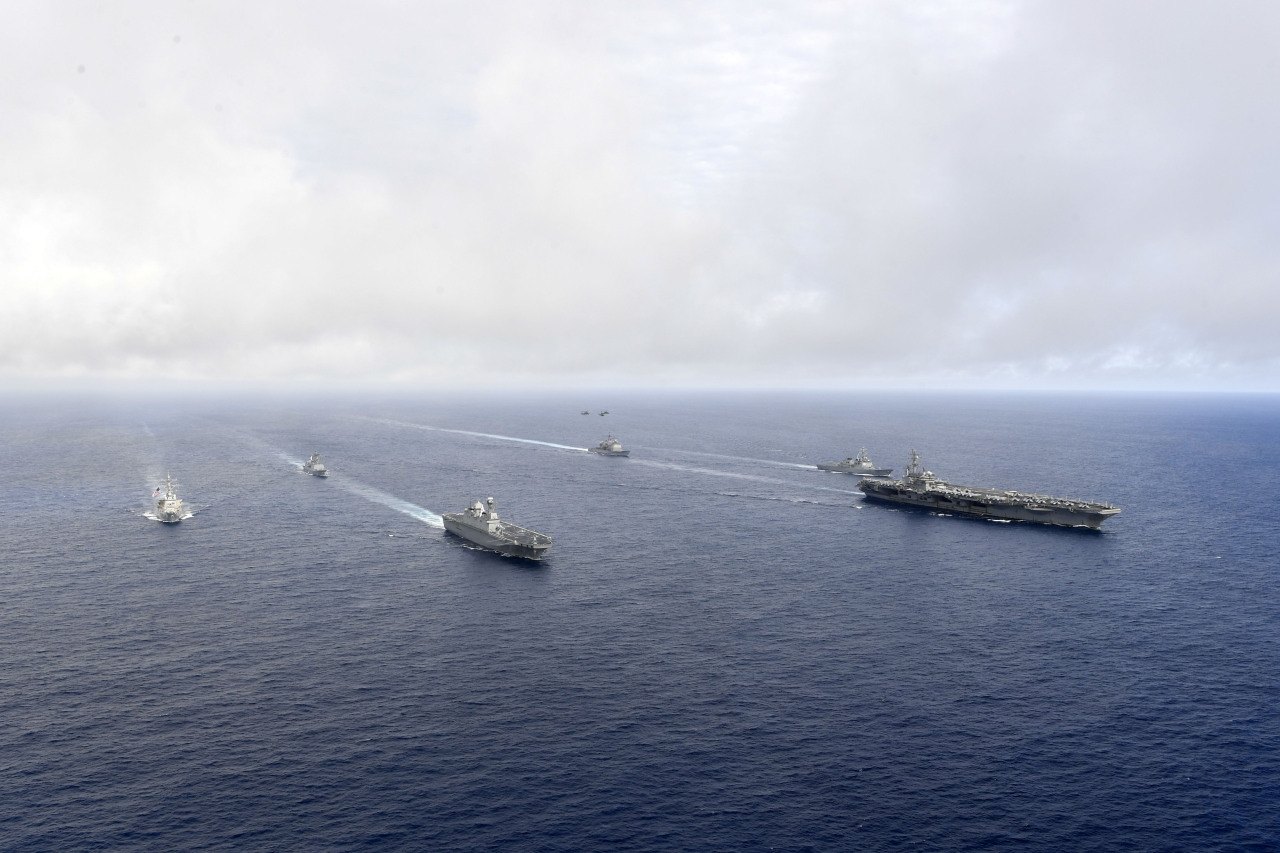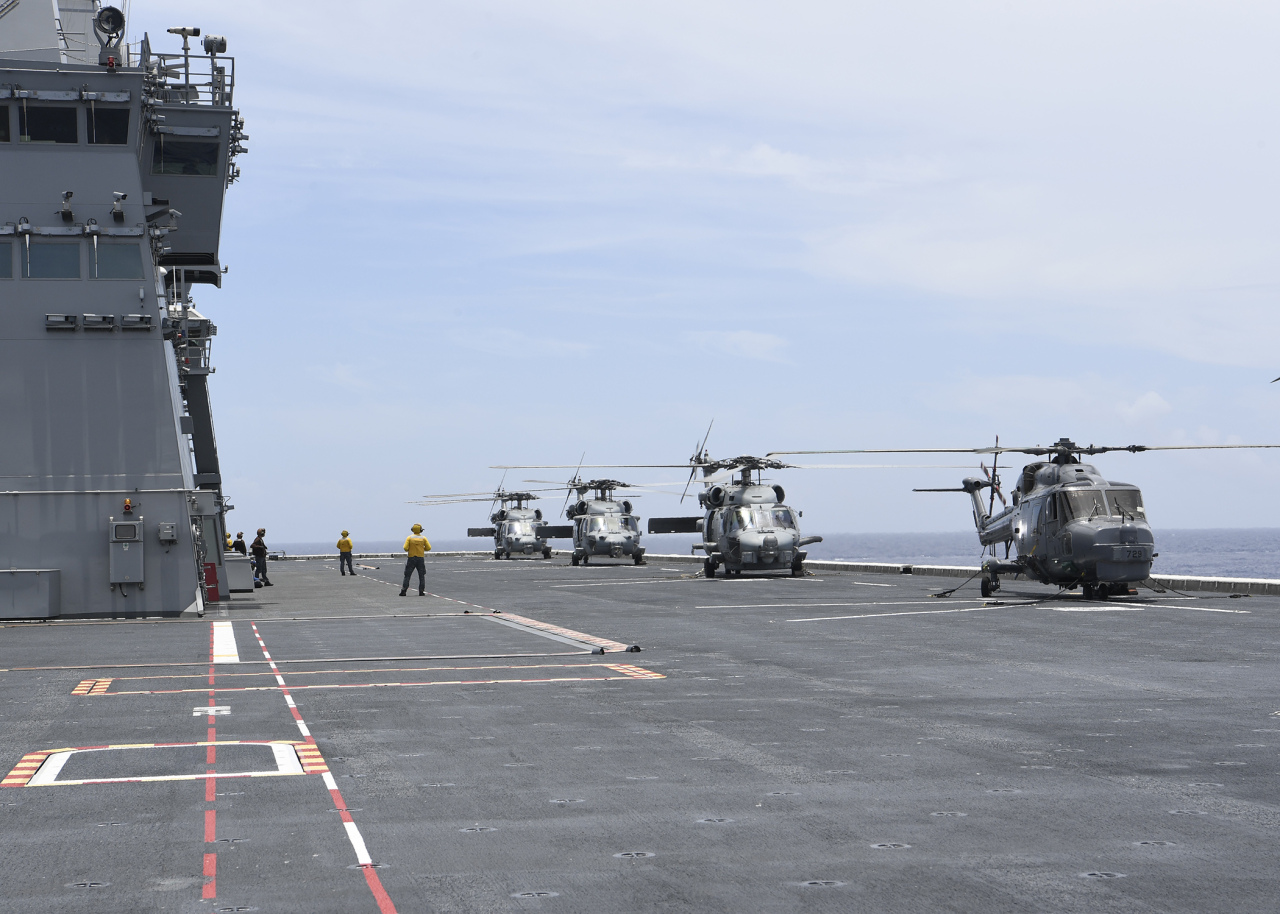US nuclear-powered supercarrier, S. Korean naval fleet conduct military drills
Large-scale naval drills are conducted to send message to North Korea
By Ji Da-gyumPublished : June 4, 2022 - 16:00

A US nuclear-powered aircraft carrier staged military drills with South Korean warships to enhance the alliance’s combat readiness against North Korea’s mounting threats and demonstrate the US commitment to defend South Korea.
The US carrier strike group conducted the bilateral military exercises with the South Korean Navy’s fleet between Thursday and Saturday in the international waters southeast of the island prefecture of Okinawa, Japan, South Korea’s Joint Chiefs of Staff announced Saturday.
The US Navy’s nuclear-powered supercarrier USS Ronald Reagan and its strike group took part in the drills along with MH-60R anti-submarine and anti-surface warfare helicopters and F/A-18 Super Hornet fighter jets.
The Ticonderoga-class guided-missile cruiser USS Antietam, the Arleigh Burke-class guided-missile destroyer USS Benfold, and the Henry J. Kaiser-class fleet replenishment oiler USNS Big Horn joined the drills.
From South Korea, the 14,500-ton Marado amphibious assault ship, which is the South Korean Navy’s largest vessel, the 7,600-ton Sejong the Great-class Aegis destroyer equipped with SM-2 surface-to-air missiles, and the 4,400-ton Munmu the Great destroyer participated in the bilateral military exercises with Lynx multirole naval helicopters.
The bilateral drills were staged as the three warships and Lynx helicopters are heading to Hawaii to take part in the US-led multinational maritime exercise.
South Korea on Tuesday dispatched the largest-scale naval fleet and a brigadier general to the biennial Rim of the Pacific (RIMPAC) Exercise which is scheduled to be conducted in waters off Hawaii for 37 days from June 29 to Aug. 4.
Warning to N. Korea
The South Korean and US navies on Thursday kicked off the maritime drills with the meeting of military commanders on board the nuclear-powered supercarrier USS Ronald Reagan. South Korean Rear Adm. An Sang-min and Rear Adm. Michael Donnelly, the US commander of Task Force 70 and Carrier Strike Group 5, commanded the maritime exercises.
South Korea’s JCS spoke of the implications of the three-day large-scale naval drills for the South Korea-US alliance and the combined defense posture as well as its message to North Korea.
“South Korea and the US have solidified the determination to decisively respond to any kind of provocations by North Korea through the combined exercises with the carrier strike group,” the JCS said in a Korean-language statement.
“(The drills) also demonstrate the South Korea-US combined defense capabilities and the US’ strong resolve to fulfill its commitment to provide extended deterrence.”
The South Korean and US naval forces have “improved their capabilities to conduct combined operations in preparation for provocation by North Korea by carrying out various naval drills such as anti-air and anti-submarine warfare exercises, maritime logistics support training and maritime interception operations,” South Korea’s JCS added.
South Korea’s Navy had originally planned to distribute a press release on the military exercise, but instead, the JCS issued the statement to effectively deliver the message to the Kim Jong-un regime, The Korea Herald learned.
The US carrier strike group conducted the bilateral military exercises with the South Korean Navy’s fleet between Thursday and Saturday in the international waters southeast of the island prefecture of Okinawa, Japan, South Korea’s Joint Chiefs of Staff announced Saturday.
The US Navy’s nuclear-powered supercarrier USS Ronald Reagan and its strike group took part in the drills along with MH-60R anti-submarine and anti-surface warfare helicopters and F/A-18 Super Hornet fighter jets.
The Ticonderoga-class guided-missile cruiser USS Antietam, the Arleigh Burke-class guided-missile destroyer USS Benfold, and the Henry J. Kaiser-class fleet replenishment oiler USNS Big Horn joined the drills.
From South Korea, the 14,500-ton Marado amphibious assault ship, which is the South Korean Navy’s largest vessel, the 7,600-ton Sejong the Great-class Aegis destroyer equipped with SM-2 surface-to-air missiles, and the 4,400-ton Munmu the Great destroyer participated in the bilateral military exercises with Lynx multirole naval helicopters.
The bilateral drills were staged as the three warships and Lynx helicopters are heading to Hawaii to take part in the US-led multinational maritime exercise.
South Korea on Tuesday dispatched the largest-scale naval fleet and a brigadier general to the biennial Rim of the Pacific (RIMPAC) Exercise which is scheduled to be conducted in waters off Hawaii for 37 days from June 29 to Aug. 4.
Warning to N. Korea
The South Korean and US navies on Thursday kicked off the maritime drills with the meeting of military commanders on board the nuclear-powered supercarrier USS Ronald Reagan. South Korean Rear Adm. An Sang-min and Rear Adm. Michael Donnelly, the US commander of Task Force 70 and Carrier Strike Group 5, commanded the maritime exercises.
South Korea’s JCS spoke of the implications of the three-day large-scale naval drills for the South Korea-US alliance and the combined defense posture as well as its message to North Korea.
“South Korea and the US have solidified the determination to decisively respond to any kind of provocations by North Korea through the combined exercises with the carrier strike group,” the JCS said in a Korean-language statement.
“(The drills) also demonstrate the South Korea-US combined defense capabilities and the US’ strong resolve to fulfill its commitment to provide extended deterrence.”
The South Korean and US naval forces have “improved their capabilities to conduct combined operations in preparation for provocation by North Korea by carrying out various naval drills such as anti-air and anti-submarine warfare exercises, maritime logistics support training and maritime interception operations,” South Korea’s JCS added.
South Korea’s Navy had originally planned to distribute a press release on the military exercise, but instead, the JCS issued the statement to effectively deliver the message to the Kim Jong-un regime, The Korea Herald learned.

First time since November 2017
The South Korea-US bilateral exercise involving the US nuclear-powered aircraft carrier was carried out for the first time since November 2017.
At the time, the USS Ronald Reagan, USS Nimitz and USS Theodore Roosevelt strike groups conducted a rare three-carrier strike force exercise with South Korea’s Navy vessels in the East Sea.
The rare bilateral naval drills were staged after South Korean President Yoon Suk-yeol and his US counterpart, Joe Biden, in May agreed to expand the scope and scale of combined military exercises in and around the Korean Peninsula in view of North Korea’s escalating missile and nuclear threats.
After the first in-person summit, Biden and Yoon also committed to further strengthening deterrence against North Korea by reinforcing the South Korea-US combined defense posture.
The two leaders promised to seek ways to strengthen the viability of the US’ extended deterrence and deploy US strategic assets such as nuclear-powered aircraft carriers “in a timely and coordinated manner as necessary.”
South Korea’s JCS on Saturday warned that South Korea and the US “have always maintained full-readiness to ensure an overwhelming victory should North Korea make a provocation.” The JCS also emphasized that the two countries will continue to “reinforce combined defense posture based on the ironclad South Korea-US alliance.”
(dagyumji@heraldcorp.com)
The South Korea-US bilateral exercise involving the US nuclear-powered aircraft carrier was carried out for the first time since November 2017.
At the time, the USS Ronald Reagan, USS Nimitz and USS Theodore Roosevelt strike groups conducted a rare three-carrier strike force exercise with South Korea’s Navy vessels in the East Sea.
The rare bilateral naval drills were staged after South Korean President Yoon Suk-yeol and his US counterpart, Joe Biden, in May agreed to expand the scope and scale of combined military exercises in and around the Korean Peninsula in view of North Korea’s escalating missile and nuclear threats.
After the first in-person summit, Biden and Yoon also committed to further strengthening deterrence against North Korea by reinforcing the South Korea-US combined defense posture.
The two leaders promised to seek ways to strengthen the viability of the US’ extended deterrence and deploy US strategic assets such as nuclear-powered aircraft carriers “in a timely and coordinated manner as necessary.”
South Korea’s JCS on Saturday warned that South Korea and the US “have always maintained full-readiness to ensure an overwhelming victory should North Korea make a provocation.” The JCS also emphasized that the two countries will continue to “reinforce combined defense posture based on the ironclad South Korea-US alliance.”
(dagyumji@heraldcorp.com)


![[AtoZ into Korean mind] Humor in Korea: Navigating the line between what's funny and not](http://res.heraldm.com/phpwas/restmb_idxmake.php?idx=644&simg=/content/image/2024/04/22/20240422050642_0.jpg&u=)

![[Exclusive] Korean military set to ban iPhones over 'security' concerns](http://res.heraldm.com/phpwas/restmb_idxmake.php?idx=644&simg=/content/image/2024/04/23/20240423050599_0.jpg&u=20240423183955)

![[Herald Interview] Why Toss invited hackers to penetrate its system](http://res.heraldm.com/phpwas/restmb_idxmake.php?idx=644&simg=/content/image/2024/04/22/20240422050569_0.jpg&u=20240422150649)
![[Graphic News] 77% of young Koreans still financially dependent](http://res.heraldm.com/phpwas/restmb_idxmake.php?idx=644&simg=/content/image/2024/04/22/20240422050762_0.gif&u=)







![[Exclusive] Korean military to ban iPhones over security issues](http://res.heraldm.com/phpwas/restmb_idxmake.php?idx=652&simg=/content/image/2024/04/23/20240423050599_0.jpg&u=20240423183955)



![[Today’s K-pop] Ateez confirms US tour details](http://res.heraldm.com/phpwas/restmb_idxmake.php?idx=642&simg=/content/image/2024/04/23/20240423050700_0.jpg&u=)